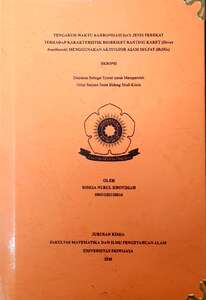KHOTIMAH, RISKIA NURUL and Mara, Ady (2025) PENGARUH WAKTU KARBONISASI DAN JENIS PEREKAT TERHADAP KARAKTERISTIK BIOBRIKET RANTING KARET (HEVEA BRASILIENSIS) MENGGUNAKAN AKTIVATOR ASAM SULFAT (H2SO4). Undergraduate thesis, Sriwijaya University.
![[thumbnail of RAMA_47201_08031182126016_cover.jpg]](http://repository.unsri.ac.id/173913/1.hassmallThumbnailVersion/RAMA_47201_08031182126016_cover.jpg)  Preview |
Image
RAMA_47201_08031182126016_cover.jpg - Accepted Version Available under License Creative Commons Public Domain Dedication. Download (179kB) | Preview |
|
Text
RAMA_47201_08031182126016.pdf - Accepted Version Restricted to Repository staff only Available under License Creative Commons Public Domain Dedication. Download (1MB) | Request a copy |
|
|
Text
RAMA_47201_08031182126016_TURNITIN.pdf - Accepted Version Restricted to Repository staff only Available under License Creative Commons Public Domain Dedication. Download (5MB) | Request a copy |
|
|
Text
RAMA_47201_08031182126016_0030046403_01_front_ref.pdf - Accepted Version Available under License Creative Commons Public Domain Dedication. Download (898kB) |
|
|
Text
RAMA_47201_08031182126016_0030046403_02.pdf - Accepted Version Restricted to Repository staff only Available under License Creative Commons Public Domain Dedication. Download (338kB) | Request a copy |
|
|
Text
RAMA_47201_08031182126016_0030046403_03.pdf - Accepted Version Restricted to Repository staff only Available under License Creative Commons Public Domain Dedication. Download (265kB) | Request a copy |
|
|
Text
RAMA_47201_08031182126016_0030046403_04.pdf - Accepted Version Restricted to Repository staff only Available under License Creative Commons Public Domain Dedication. Download (453kB) | Request a copy |
|
|
Text
RAMA_47201_08031182126016_0030046403_05.pdf - Accepted Version Restricted to Repository staff only Available under License Creative Commons Public Domain Dedication. Download (183kB) | Request a copy |
|
|
Text
RAMA_47201_08031182126016_0030046403_06_ref.pdf - Bibliography Restricted to Repository staff only Available under License Creative Commons Public Domain Dedication. Download (202kB) | Request a copy |
|
|
Text
RAMA_47201_08031182126016_0030046403_07_lamp.pdf - Accepted Version Restricted to Repository staff only Available under License Creative Commons Public Domain Dedication. Download (810kB) | Request a copy |
Abstract
This research discusses the effect of carbonization time and type of adhesive on the characteristics of rubber twigs (Hevea brasiliensis) biobriquettes using sulfat acid activator (H2SO4). The purpose of this research was to determine the effect of carbonization time and the use of adhesive types of resin gum, latex gum, and tapioca starch on the manufacture of biobriquettes from rubber twigs on the characteristics of rubber twigs biobriquettes and determine the optimum calorific value of rubber twigs biobriquettes based on carbonization time and adhesive type. This research uses rubber twigs as raw material for making biobriquettes because of the existence of rubber twigs that have not been optimally utilized and have a large enough calorific value so that they have the potential to be processed into an alternative energy source in the form of biobriquettes. In addition, rubber twigs are an energy source from biomass, which releases less CO2 and is involved in the natural carbon cycle so that there is no buildup in the atmosphere. The manufacture of biobriquettes from rubber twigs in this research uses the carbonization method with carbonization times of 30, 60, and 90 minutes. This research also uses several types of adhesives. The results of the analysis in this research refer to SNI 01-6235-2000. Based on the results of the research, the optimum valued was biobriquettes with carbonization time of 90 minutes, 30% tapioca starch adhesive, moisture content of 4.161%, ash content of 3.615%, volatile matter of 24.975%, fixed carbon of 67.249%, calorific value of 5,784.523 cal/g, mass density value of 0.810 g/cm3 and drop test of 1.196%.
| Item Type: | Thesis (Undergraduate) |
|---|---|
| Uncontrolled Keywords: | Energi, biomassa, biobriket, ranting karet |
| Subjects: | Q Science > QD Chemistry > QD450-801 Physical and theoretical chemistry |
| Divisions: | 08-Faculty of Mathematics and Natural Science > 47201-Chemistry (S1) |
| Depositing User: | Riskia Nurul Khotimah |
| Date Deposited: | 23 May 2025 07:09 |
| Last Modified: | 23 May 2025 07:09 |
| URI: | http://repository.unsri.ac.id/id/eprint/173913 |
Actions (login required)
 |
View Item |
